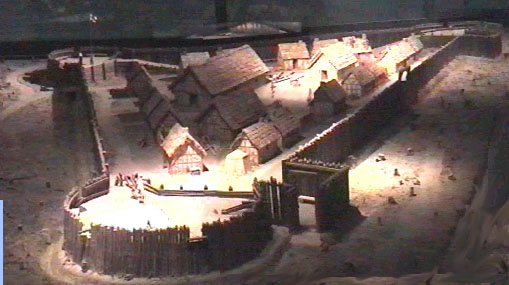
Jamestown diorama, 1607
104 English men and boys anchored on the James River May
13, 1607. By the end of the summer the Colonists were in trouble
-- dying from disease and starvation.

Jamestown diorama, 1607 |
Santa Fe, New Mexico was established
a few years earlier by the Spanish, but back then they might as well have
been on two different planets.
104 English men and boys anchored on the James River May
13, 1607. By the end of the summer the Colonists were in trouble
-- dying from disease and starvation.
|
| If it had not been for the organizational skills of John
Smith and the generosity of the local natives they all would have died.
But soon they had a small settlement and the urban sprawl of America was
underway.
I like the way they drove piles using oxen. It must have taken the better part of a day just to move the pile driver. |
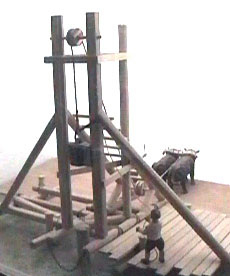 |
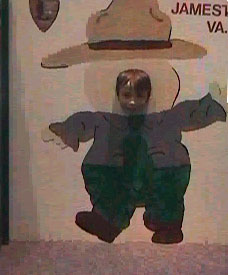 |
Hey, I'm a Junior Ranger. Do you think he'll remember this when he's forty? |
| Colonial Williamsburg is about 25 square blocks of preserved
history. Here, for example, is a mill used to process grain.
Colonial Williamsburg is a living history museum, or should I say town.
Many of the buildings here are original and others have been rebuilt to
every detail. In addition, it blends right into the existing town
of Williamsburg and neighboring College of William and Mary.
This mill is different from others we've seen. In order to catch the wind the entire mill is turned. Even the stairs are supported by a large timber with a wagon wheel, seen here in the lower right-hand corner. |
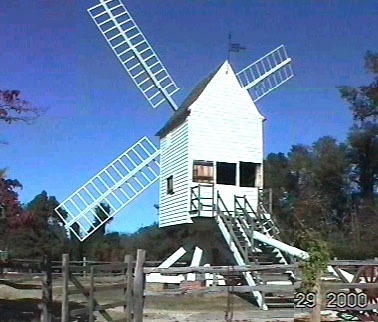 |
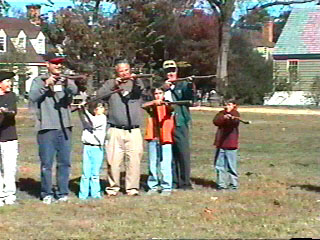 |
From Fort Laramie to Williamsburg,
we saw several demonstrations of muskets and cannons. I bet we'll
see some more when we study Civil War history.
Here, Mitch and Max had a chance to join in drills.
It was really quite comical. The Sergeant, with a voice and stature
similar to John Wayne's, was barking out orders to this group of new, very
green recruits.
|
Since these were really unloaded four foot tree branches,
he had them make sounds for the pulling back the flintlock and firing the
gun.
So when he said, "Fire", we heard: "bang BANG bang
bang." Then he'd shout, "I said fire simultaneous, not when you feel
like it!" "And you -- what's this "loud bang" stuff -- do you know
what we do to smart allics in 1774?"
This went on for fifteen to twenty minutes and the adults were just as confused as the kids. They did start to look pretty good by the end, however. Max wanted to come back the next day just to do drills again.
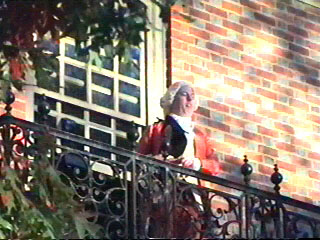 |
Each day has a theme significant in American history in Williamsburg. Sunday starts off as November 7, 1769. At this time in history most Virginians believed the problems with Britain could be worked out without resorting to violence. On this day, Lord Botetourt, the king's appointed Royal Governor of Virginia, arrived from England. |
Monday's theme was December 4, 1774, (5 years later), when the then Royal Governor Lord Dunmore returns from the west, (western Virginia), fresh from a victory over the Shawnee Nation. This opens up the west for colonial expansion but troubles are brewing.
By Wednesday, representing April 28, 1775, antagonism between Virginia and the British reach a boiling point. British solders have removed the colony's gun powder from the magazine (store house) and troubling rumors of bloodshed in Massachusetts reaches town.
Thursday and Friday's theme are "The Sword is Drawn" and "Virginia Declares Independence." By Saturday, May 16, 1776, the theme is "Building a New Republic"
At this point in history many of the colonies believed it best to become separate independent states. Virginia was the first to declare their independence.
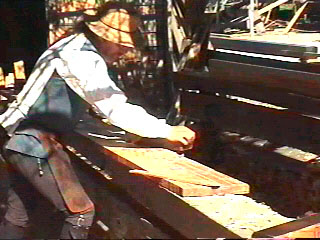 |
But amongst all the hoopla of politics, we were still able to watch a craftsman plane a plank smooth. Hand cutting and planing planks and boards for a house sure added to the labor cost back then. |
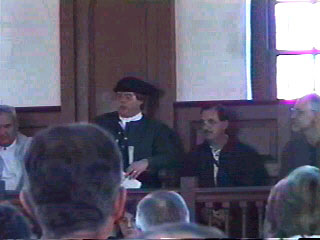 |
Here we attend a mock trial in the courthouse. Several disputes are heard ranging from a tavern bill, to tax evasion. |
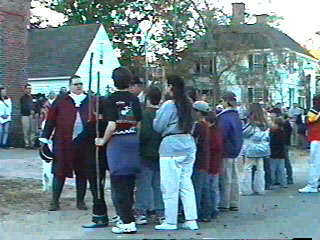 |
Remember that Lord Dunmore returned from the west?
Well, the local colonial troops gather for inspection by the Lord Dunmore,
the Royal Governor. Sure, I agree this is a rather shabby looking
bunch and their weapons are a bit rustic.
Well, Lord Dunsmore refused to inspect the troops, not
recognizing them as official military troops. So they marched over
to John Wythe's house where the Speaker of the House was visiting. The
Speaker graciously inspects and recognizes the colonial militia.
Needless to say the tensions were rising between the Colonists and the
British.
|
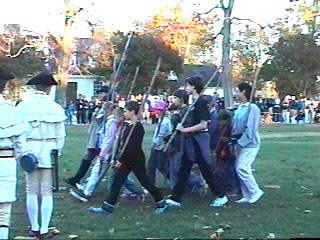 |
Here's another picture marching. Max is in the middle of the last row. Why sit and read about history when you can come here and almost live it. This is a great way for the kids (and adults) to learn. We saw lots of school groups here, as well as in Philadelphia and Washington D.C. I wonder if growing up on the east coast makes any difference in their understanding of American history since the kids can more easily go see the actual sites. But on the other hand, it's amazing how many middle-aged
people we meet that have never been out of their home state, (and the states
aren't that big on the east coast). So I'm not sure whose got it
better, but the west is different from the east in several ways.
|
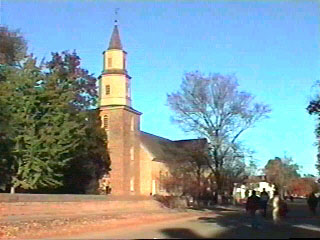 |
Here's Burton Parish Church, an active church today.
I can't remember the actual date of construction, but I believe it is 250
years old now.
We leave next week, November 10th, for Europe. This
church will probably seem like new construction by time we get back.
|
| Another original home is that of the prominent attorney and teacher to Thomas Jefferson, George Wythe. |
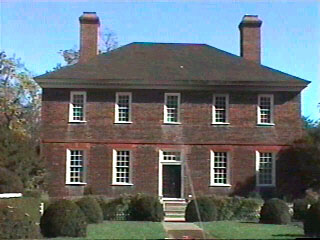 |
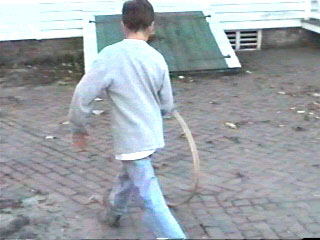 |
Behind the George Wythe house on weekends some local
children dress in period costumes and display board games and toys that
were common in Williamsburg in the 1770's.
Mitch is playing here with a hoop and stick. The
idea is to push the hoop along with a small stick.
|
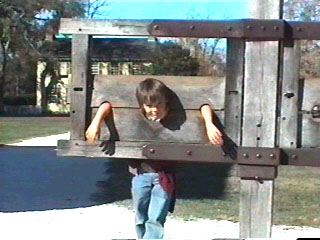 |
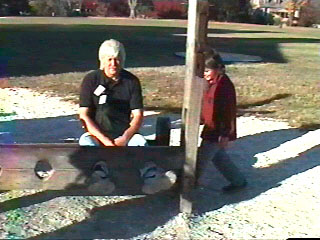 |
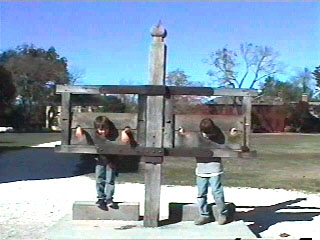 |
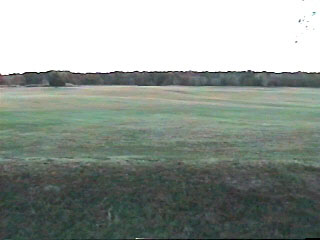 |
The Battlefield. It doesn't take too long to look over the battlefield. If you have time to study the battle it is interesting to see first hand how it played out; who was where, who had the big cannons, who had ships offshore, and the planned strategy versus the reality of the battle. |
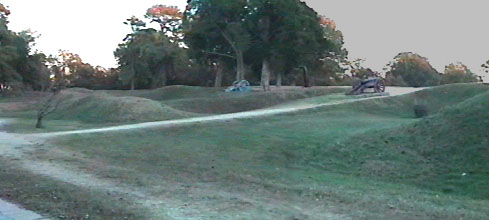 |
So how do I fit the whole story along side one picture?
Well, here it goes.
The British were having a battle of egos between the generals. One was in Yorktown and the other one in New York. The one in Yorktown, Cornwallis, was supposed to stay in the Southern colonies, but he decided on his own to travel north to Yorktown. He ended up getting himself stuck there, so asked the general in New York for reinforcements. Well, the British Navy from New York arrived too late
and too short. The French, who were American's allies, had a fleet
of 20 or more ships blocking the harbor to Yorktown. When the British
fleet finally arrived, the British Admiral did just about everything wrong
in the battle at sea and went limping back to New York. Meanwhile,
Washington was marching to Yorkstown. Ultimately, the Cornwallis
surrendered. The story goes that he was so humiliated that he sent
his second officer to surrender his sword, so General Washington sent his
second officer to accept it.
|
Today all of the earthen mounds, ditches and ridouts that were dug over two hundred years ago are still there.
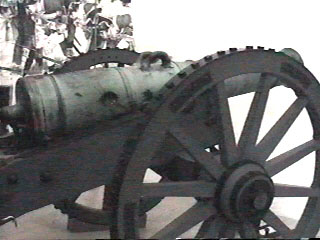 |
Here's one of the smaller field cannon used by the English. The American and French Forces had much larger 24 and 16 lb. siege cannons that could blow about timber reinforced earthen mounds and "earthworks". The British's larger cannons never arrived from New York. |
| Word has it that General Lafayette, (who was one of America's
best allies), saw this cannon several years later and he recognized it
as one that was hit and captured during the battle. He then gave it a sentimental
embrace. Today this cannon sits in the visitor center at Yorktown.
Well that's the end of the Revolutionary war and all with just a few paragraphs and four pictures. |
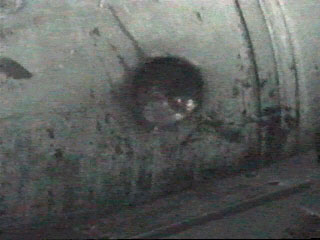 |
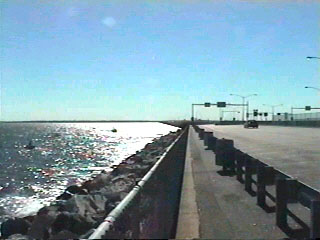 |
Leaving Virginia we headed south across the Chesapeake Bay to Maryland on our way to Delaware for the 15th annual Punkin-Chunkin event. The bridge-tunnel complex that crosses the bay is 17 miles long and is said to be the world's largest bridge-tunnel combination. |
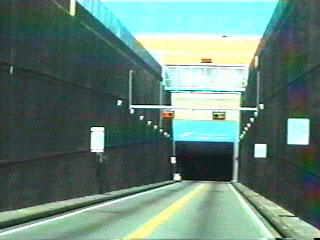 |
As we drove along about twenty feet above the water surface, we suddenly found the bridge deck heading down below the water line. I've driven through underwater tunnels before but never one that starts three miles out into a bay. |
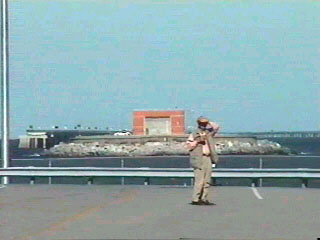 |
Here, I stopped where our road ended and took a picture across to the other side of the tunnel. I have the camera zoomed way in so the other side of the tunnel is really further away than it looks. It was really cool because as we were approaching the tunnel a large Navy ship was approaching the passage at a pretty good clip. While driving, we couldn't yet see the tunnel and opening. It looked as if the ship was going to ram the roadway just ahead of us. |
The guy in this picture is another story. I'm about
200 yards away from him with the zoom lens. He was walking across
and I was waiting for him to cross out of the way, but when he spotted
me in the middle of the highway he stopped to see what I was doing. Well,
I didn't want to stand there too long so he ended up on our webpage.
Here's looking at you!
|
|
|
|
|
ã
copyright Nodland 1999-2020